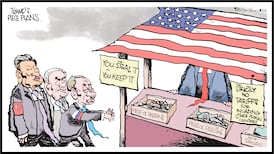Before Christmas, my wife got a taxi from Dublin Airport on her own. The driver, a middle-aged man, did not have the licence with his name and photograph on display.
When she asked him politely about this, he huffed: “I’m not going to harm you. I’m just a typical Irish man.” When she replied that this did not give her much comfort, he was outraged.
Here’s the difference. If I had been in that car on my own, I’d have been annoyed and concluded the driver was an idiot.
A woman in that car on her own has to be afraid and wonder if the man is hiding his identity because he is a rapist. Gender ups the ante, tenfold.
Fintan O’Toole: When and why did ‘flats’ become ‘apartments’ in Ireland?
Fintan O’Toole: Ireland would not be viable without 10 big US corporations
Fintan O’Toole: If 2022 is to be different, we need to act sooner on predictable events
Fintan O’Toole: Ireland is now demonstrably less politically corrupt than England
Women learn from girlhood to be cartographers. They make maps in their heads, atlases of danger, charts of the reefs and shoals around which they must plot their courses, away from misogynistic men.
Two years ago, after a brutal sexual assault in a public place, South Dublin County Council commissioned a close-up study, written by Lorraine McMahon, of how women in the working class suburb of Clondalkin relate to where they live.
It mapped a densely populated area: Neilstown Shopping Centre and its environs, some local streets, Letts Field and the main green space amenity, Collinstown Park.
What became clear is that the places women fear are not beyond the Pale. They are familiar, well-trodden – by men.
Women worry about the shopping centre: “This area is another world after dark, it just doesn’t feel safe, even the chipper closes early… Many women who drive will not use the parking spaces at the back of the shops.”
The walkway from the shopping centre to the Garda station is a virtual no-go area for women and girls. It’s a convenient shortcut for men and boys, but “Even as a young confident woman who knows the area well, I would not use that path after dark… It’s the fear of not being seen if something happened, fear of the unknown.”
The side road between the childcare centre and St Peter Apostle primary school is described as an area “where groups can hang around and sexual harassment happens as they egg each other on”.
Letts Field was where the sexual assault that prompted the study had taken place in 2016. Four years later, in 2020, a miasma of fear still rose from it: “When driving over the Neilstown bridge, once I get to the junction of Letts Field I feel different, become hyper-vigilant due to the rape there. The fear of attack is still there, even when I am in the car.”
In relation to the shops at Rowlagh: “I was going to the Chinese with my daughter [20 years of age]. When we arrived, she was too frightened to get out of the car due to the level of the crowd hanging about. Some of the gang came up to the car making sexual gestures and comments. This was frightening.”
As for the park, supposedly a facility for everyone, “I am well known in the area, walk my dog daily and still wouldn’t walk in and around Collinstown Park for fear of attack, even with my dog.”
No-woman’s land
The point is that these are not marginal spaces. The no-woman’s-land is not a no-man’s-land. It is the terrain of the everyday: the shops, the roads, the shortcuts, the park. Men don’t think much about it; women must.
And, no, this is not just because Clondalkin is a working class area. Deprivation and poor maintenance of the public realm by the council amplify the problem, but they are not at its root.
I live in a safe, long-settled middle class part of Dublin.
Almost directly across the road from my house, the body of a 34-year-old woman, the mother of four children, was dumped beside a skip. I remember the neighbour who found her having to tell the media: “She was blue in the face, the colour of death.”
The dead woman’s husband was convicted of killing her. The jury watched the video evidence of her five-year-old son recounting how he saw his daddy “hammering” his mammy on the head.
Round the corner lives another man, a wealthy aviation broker. He was convicted of sexually assaulting a young woman who was simply walking home along the avenue.
Such incidents, and the thousands of more low-level encounters infused with sexual threat, leave radioactive traces of dread. Every woman walks around with a mental Geiger counter that crackles with static at certain locations and in certain situations. No man does.
Men fear specific threats that come and go. Women live with a baseline level of threat, just below the surface of consciousness. They are twice as likely as men to fear becoming the victim of a violent crime.
Perhaps, at this moment, there’s a thing every man could do. Just walk around the local park. Go on the bus. Get a taxi.
But imagine as you do so that you are a girl or a woman. What are you wearing? How are you holding your body? What vibes are you giving off? What’s behind that bush? Who’s around that corner? And why does that driver refuse to reveal who he is?















